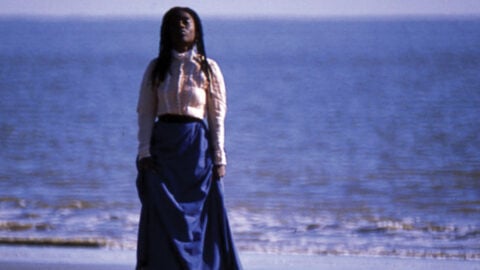News to Me: John Smith, John Berger, and Jean-Luc Godard

The Image Book (Jean-Luc Godard, 2018)
1. A few weeks back, we reported on the SXSW-Amazon collaboration that aims to bring the festival to the public via Amazon Prime’s streaming service. Though details were scant at the time, a number of filmmakers are now speaking out against the project—“Unfortunately, showing things for free isn’t going to make a dent . . . the best thing these platforms can do is go back into business and start buying films.” Another producer, speaking to Inverse this time, said: “There’s a huge difference between having a thousand people see your film and selling it based on buzz, and having 300 million people see your movie unlimited times for ten days. If you were a distributor, would you buy and market a movie shown to everyone who has an Amazon account, which is basically all of America? I wouldn’t.”
2. With very few new films being released of late, a number of publications are digging through their archives and making previously print-only articles available for everyone. Among them: Sight & Sound have released this piece on Charlie Chaplin and “the art of falling” by John Berger (who passed away just a few years back—the New Yorker’s obituary a great introduction to his work and worldview). In his article, Berger introduces Chaplin’s Little Tramp with fitting melancholy: “He undergoes humiliation after humiliation with equanimity. Even when he counter-attacks, he does so with a hint of regret and with equanimity. Such equanimity renders him invulnerable—invulnerable to the point of seeming immortal. We, sensing this immortality in our hopeless circus of events, acknowledge it with our laughter.”
3. Quarantine screenings continue over at Kino Slang, this week featuring one film from Jean-Luc Godard and another from Luis Buñuel. Godard’s What’s Wrong with the World, just one-minute long, is rarely cited even in the most exhaustive lists of his work, originally presented on live television in 1996 as one of four “scales” (think Do-Re-Mi), with Godard asking why filmmakers don’t do their scales every morning like other artists. And from Buñuel: It’s Called the Dawn, for which programmer Andy Rector quotes André Bazin: “a strange film because of its simplicity, dazzling because of its clarity, and a film which cleanses the soul and heart.”
4. “Is cinema becoming a dead language—an art form which is already in decline?” Wim Wenders posed this question to his filmmaker subjects during the 1982 Cannes Film Festival. His documentary, Room 666, gave each director one 16mm reel to answer the question, and featured the likes of Jean-Luc Godard, Rainer Werner Fassbinder, and Michelangelo Antonioni. Since 2016, Eric Hynes, Jeff Reichert, and Damon Smith have been revisiting the question with their ongoing ROOM H.264 project. Its latest installment, ROOM H.264: Quarantine, April 2020, is now available, alongside previous editions, featuring a number of directors whose work was set to screen at since-cancelled festivals.
5. Cahiers du Cinéma have published their last issue to be led by Stéphane Delorme’s editorial team—all of whom resigned after a recent change in ownership. (Delorme’s editorial farewell, from the March issue, is available here.) The latest issue boasts a familiar cover, adorned by Godard’s The Image Book and just one question: Qu’est-ce que la critique? Or, What is criticism? The issue contains a number of essays on the subject, as well as an interview with John Waters and a tribute to the late Max von Sydow. Back in March, Richard Brody published this piece on what’s “at stake” in the Cahiers takeover: “The legacy of every venerable periodical is complex and potentially burdensome, and knowing when to change directions is as crucial to a magazine’s survival as knowing when to stay the course.”
6. “As I said to The New York Times when I was let go from Variety just over a decade ago, ‘It’s the end of something.’ What the next something is—for everyone in our business—seems less knowable than ever.” Longtime film critic Todd McCarthy was recently let go by The Hollywood Reporter, following a number of shake-ups at the publication. For Deadline, McCarthy recounts his industry experience—working as an assistant for Elaine May, pretend-partying for Orson Welles; a continuous cycle of getting fired and re-hired during the tumultuous lifespan of the trades. We recently digitized this interview with François Truffaut, conducted by McCarthy and Joseph McBride for our September-October 1976 issue.
7. This Thursday, April 23, the Czech Center New York will be hosting a series of four films, beginning with Karel Zeman’s The Fabulous Baron Munchausen. In an essay for Criterion, Michael Atkinson introduces the film: “As undisturbed by history or science or reality as the baron himself, the film begins, Verne-ishly, with proto-astronauts meeting the eponymous yarn master on the moon, and lollygags through his discursive, chaotic avalanche of artful baloney in a way that feels far more like pretend-play than narrative progression.” Zeman’s film will be followed by a Q&A with critic A.S. Hamrah, and the series will conclude with Tomáš Vorel’s The Prague Five.
8. More on the national cinema front: A dozen classic films from China’s first “Golden Period” have been made available—with subtitles—on YouTube, thanks to the Department of Asian Studies at the University of British Columbia. RADII have published a few words on some of the more important works—Laborer’s Love, Goddess, and Spring in a Small Town. For a more contemporary view of the Chinese film industry—and its greatest auteurs—check out Tony Rayns’ piece from our September-October 2013 issue, which talks about Jia Zhang-ke, politically-charged production struggles, and the favorite films of President Xi.
9. When we posted the News last week, we had only just heard of Sarah Maldoror’s sad passing, which happened that same morning. Our brief mention is hardly enough to celebrate her life and work, and for that reason we point you now to Sabzian’s obituary. The article features links to a number of Maldoror’s films—including one of her most famous, Sambizanga—as well as her television-film Le passager du Tassilli and her short La tribu du bois de l’é, this longform interview for CNRS, and a farewell letter from her daughters.
10. For the month of April, This Long Century will be streaming two programs—INSIDE and OUTSIDE—comprising 30 films in total, with work by Carlos Reygadas, Sky Hopinka, and Apichatpong Weerasethakul, among others. The works were donated by the filmmakers for free, asking in return that you donate to one of their selected relief funds and non-profits. Also included in that line-up is one of John Smith’s typically-cheeky works, Om, and we leave you this week with perhaps his most famous film, The Girl Chewing Gum.





